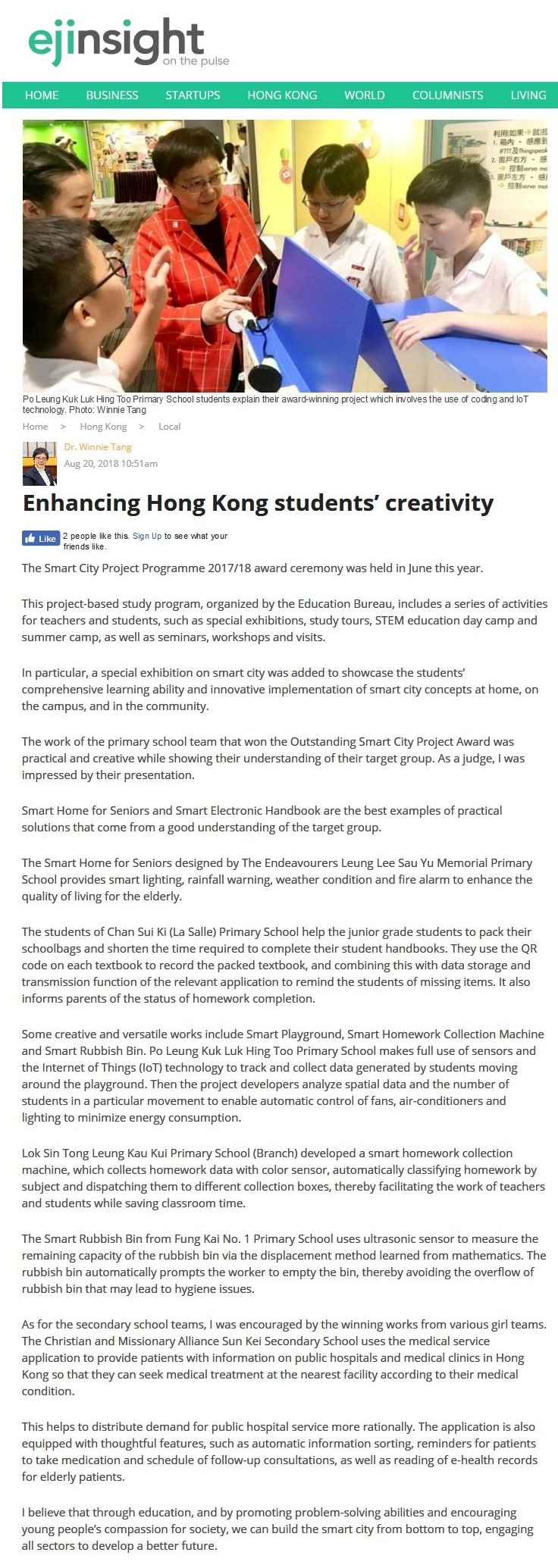網上版請按此

Enhancing Hong Kong students' creativity
The Smart City Project Programme 2017/18 award ceremony was held in June this year.
This project-based study program, organized by the Education Bureau, includes a series of activities for teachers and students, such as special exhibitions, study tours, STEM education day camp and summer camp, as well as seminars, workshops and visits.
In particular, a special exhibition on smart city was added to showcase the students' comprehensive learning ability and innovative implementation of smart city concepts at home, on the campus, and in the community.
The work of the primary school team that won the Outstanding Smart City Project Award was practical and creative while showing their understanding of their target group. As a judge, I was impressed by their presentation.
Smart Home for Seniors and Smart Electronic Handbook are the best examples of practical solutions that come from a good understanding of the target group.
The Smart Home for Seniors designed by The Endeavourers Leung Lee Sau Yu Memorial Primary School provides smart lighting, rainfall warning, weather condition and fire alarm to enhance the quality of living for the elderly.
The students of Chan Sui Ki (La Salle) Primary School help the junior grade students to pack their schoolbags and shorten the time required to complete their student handbooks. They use the QR code on each textbook to record the packed textbook, and combining this with data storage and transmission function of the relevant application to remind the students of missing items. It also informs parents of the status of homework completion.
Some creative and versatile works include Smart Playground, Smart Homework Collection Machine and Smart Rubbish Bin. Po Leung Kuk Luk Hing Too Primary School makes full use of sensors and the Internet of Things (IoT) technology to track and collect data generated by students moving around the playground. Then the project developers analyze spatial data and the number of students in a particular movement to enable automatic control of fans, air-conditioners and lighting to minimize energy consumption.
Lok Sin Tong Leung Kau Kui Primary School (Branch) developed a smart homework collection machine, which collects homework data with color sensor, automatically classifying homework by subject and dispatching them to different collection boxes, thereby facilitating the work of teachers and students while saving classroom time.
The Smart Rubbish Bin from Fung Kai No. 1 Primary School uses ultrasonic sensor to measure the remaining capacity of the rubbish bin via the displacement method learned from mathematics. The rubbish bin automatically prompts the worker to empty the bin, thereby avoiding the overflow of rubbish bin that may lead to hygiene issues.
As for the secondary school teams, I was encouraged by the winning works from various girl teams. The Christian and Missionary Alliance Sun Kei Secondary School uses the medical service application to provide patients with information on public hospitals and medical clinics in Hong Kong so that they can seek medical treatment at the nearest facility according to their medical condition.
This helps to distribute demand for public hospital service more rationally. The application is also equipped with thoughtful features, such as automatic information sorting, reminders for patients to take medication and schedule of follow-up consultations, as well as reading of e-health records for elderly patients.
I believe that through education, and by promoting problem-solving abilities and encouraging young people's compassion for society, we can build the smart city from bottom to top, engaging all sectors to develop a better future.
Dr. Winnie Tang
Honorary Professor, Department of Computer Science, The University of Hong Kong